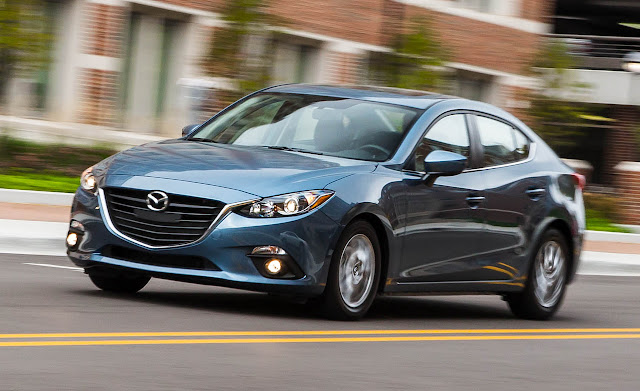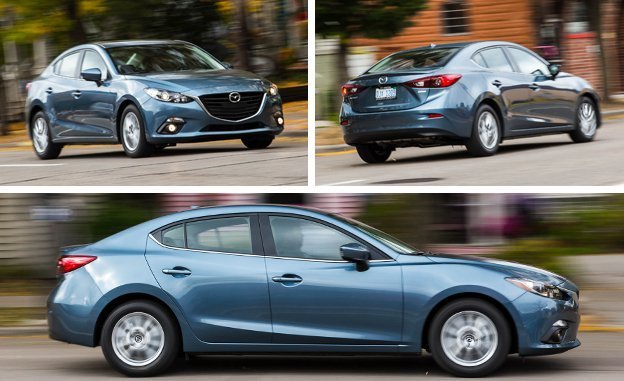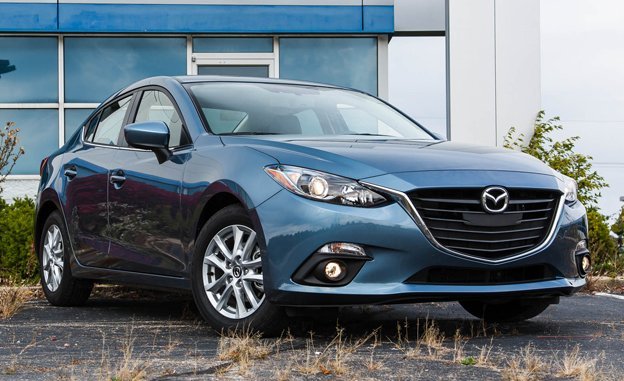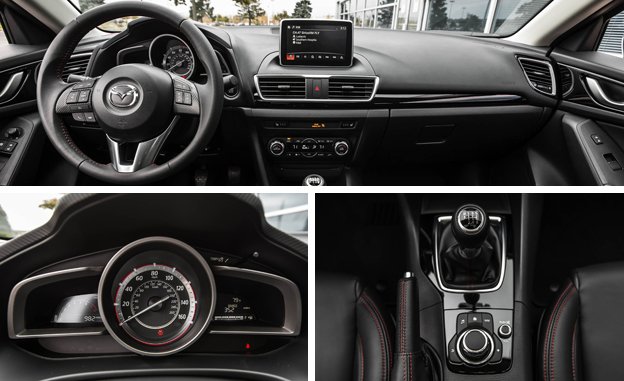Many carmakers are fond of employing the term “DNA” in describing their vehicle lineups, but few have as much product justification for doing so as Mazda, and fewer still exhibit as much restraint. We hear a lot about zoom-zoom, of course, but that, too, seems justified. From top to bottom, Mazda’s offerings are uniquely uniform in terms of one key DNA trait: an engaging driving experience.
You’d expect that from the little MX-5 Miata sports car, of course. But you might not from the much bigger and more utilitarian CX-9 crossover, Mazda’s family wagon. Nevertheless, it’s there, right across the board. And it certainly distinguishes the Mazda 3 from most others in the compact corral. Hatchback or sedan, the 3 tops our compact-car rankings, largely on the strength of its athleticism, although for 2016 Mazda also has ramped up the 3’s value.
For example, Mazda has trimmed the pricing for the basic 3 i Sport by $600, to $18,665, while at the same time expanding its standard feature content. Our 3 i Grand Touring test car—which essentially lacked only LED exterior lighting and real leather to be top-of-the-line—included navigation, a 7.0-inch touch-screen display, Bose nine-speaker audio, heated front seats, dual-zone automatic climate control, cruise control, a leather-wrapped steering wheel and shift knob, Bluetooth with text-messaging capability, Pandora, a rearview camera, a blind-spot monitor, and rear cross-traffic alert. The only option was a $70 cargo mat. By compact-class standards, it adds up to a pretty comprehensive package for less than $23,500.
2.0 vs. 2.5
Our test car was powered by the 3’s basic 2.0-liter four-cylinder. Adding about two grand will put the optional 2.5-liter four under the hood, with 184 horsepower and 185 lb-ft of torque compared with the 2.0-liter’s modest totals of 155 and 150.
Consistent with Mazda’s sporting ethos, both engines can be paired with either a six-speed manual (standard) or a six-speed automatic transmission. Our test example had the manual, with its endearingly crisp engagements enhanced by a very sweet clutch.
The zero-to-60-mph run takes 7.5 seconds. That’s not a thrill ride, and it’s just 0.1 second quicker than a 2.0-liter paired with the six-speed auto. On the other hand, it’s only a couple tenths behind a 2.5-liter manual hatchback we tested. The acceleration disparity magnifies as the drag race goes on—the 2.5 hatch reached 100 mph 2.1 seconds quicker than the 2.0 sedan. Even though that particular hatchback weighed in 120 pounds heavier than this sedan, horsepower eventually will tell. The point, though, is to decide whether a few tenths in such a test are worth the extra money.
And the further point is that, 2.0 or 2.5, acceleration isn’t the 3’s primary appeal. It will hold its own in the daily-commute derby, but where this car comes into its own is on a two-lane back road with a variety of turns and a paucity of traffic. Chassis rigidity is on par with a bridge girder, body motions are modest, the car responds to inputs with immediacy, and the electric power steering is quick (2.6 turns lock-to-lock), informative, and dead-bang accurate. Attention steering engineers worldwide: Check out this system, learn, adopt.
Is there understeer? Sure, and you’d expect that in a front-drive car. But it’s modest. Grip—0.86 g on our skidpad—is better than modest, even with a set of relatively high-profile all-season Bridgestone Ecopias (205/60-16). Braking performance could be a little better, and on the test track we noted hints of fade. However, fade wasn’t an issue in our real-world exercises, the pedal is easy to modulate, and tires less focused on fuel economy undoubtedly would improve stopping distances.
Speaking of, fuel economy is rated at 29 mpg city and 41 highway by the EPA. Once again, we underachieved, logging 29 mpg on suburban and rural roads. Summoning haste from the 2.0-liter engine doesn’t do much for fuel economy.
The dark side
The interior of our test car will look okay at a glance—provided the beholder is partial to black. Although there are little licks of silvery material here and there, the overall impression is midnight at the oasis. A few small, carbon-fiber-look trim panels don’t do a lot to relieve the darkness.
The front seats provide adequate lateral support, but the bottom cushions feel a little thin. And making adults happy in the rear seat will require territorial concessions by those up front.
Assessed as eye candy, the Mazda 3 sedan has a family look, with attractive sculpting in the side sheetmetal, enhanced by a snappy set of 16-inch aluminum wheels. We still prefer the more athletic looks of the hatchback version, but the sedan isn’t a wallflower, either.
Leaving dynamics out of the equation, the Mazda 3 stacks up as a modestly attractive compact sedan with good fuel economy and a solid value story. But dynamics are this car’s strong suit—and the prime reason we see the 3 as tops in its class.
As the age of the autonomous automobile draws ever nearer, Mazda continues to be guided by the premise that operating a motor vehicle should be both involving and gratifying. The new corporate mantra sums it up: Driving matters. Long may it last.












0 commentaires:
Enregistrer un commentaire